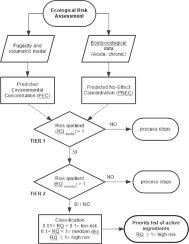Science of the Total Environment ( IF 9.8 ) Pub Date : 2021-01-21 , DOI: 10.1016/j.scitotenv.2020.144716 Claudia Alvarado-Flores , Francisco Encina-Montoya , Felipe Tucca , Rolando Vega-Aguayo , Jorge Nimptsch , Carlos Oberti , Erico R. Carmona , Carlos Lüders

|
The global aquaculture industry has grown exponentially in recent years using to control of infections and diseases, a variety of veterinary drugs (VMP) are used, including antibiotics, antifungals and antiparasitics, which have different routes of emission, environmental persistence and side effects to aquatic organisms, becoming one of the main concerns in its use of veterinary drugs (VMP) and its potential toxicological impact on the environment, in this context, Chile is considered one of the main salmon producers. Ecological risk assessment of active principles used infreshwater fish farms worldwide and in Chile were investigated. We recollect a physical - chemical properties of active principles used by fish farms and we could estimate the relative hazard a priori. Later active principles grouped as antibiotics (n = 6), antiparasitics (n = 5), anesthetics (n = 3), and disinfectants (n = 7) were assessed using a mass balance model based on fugacity was developed for each active principle under treatments via immersion and food administration in fish, while a volumetric model for disinfectants and sodium chloride was used for estimating the predicted environmental concentration (PEC), under a real smolt farming scenario in fish farms. Ecotoxicological data were collected from open literature to predict the no-effect concentration (PNEC). The ecological risk assessment was characterized using a risk quotient (RQ = PEC/PNEC) based in two assessment tiers. Results revealed that 12 active ingredients showed a high risk (RQ ≥ 1), thus indicating that adverse effects could occur and further investigation with measured concentrations in the field are required to reduce exposure in surface waters.
中文翻译:

评估淡水养鱼场目前使用的有效成分的生态风险
近年来,全球水产养殖业用于控制感染和疾病已成倍增长,使用了多种兽药(VMP),包括抗生素,抗真菌药和抗寄生虫药,它们具有不同的排放途径,环境持久性和对水生生物的副作用生物,已成为其使用兽药(VMP)及其对环境的潜在毒理学影响的主要关注之一,在这种情况下,智利被认为是鲑鱼的主要生产国之一。对全世界和智利的淡水养鱼场使用的有效成分的生态风险评估进行了调查。我们回顾了养鱼场使用的有效成分的物理-化学性质,并且可以先验估计相对危害。后来的有效成分归类为抗生素(n = 6),抗寄生虫药(n = 5),麻醉药(n = 3)和消毒剂(n = 7)是基于质量平衡模型进行评估的,该模型基于在鱼中通过浸泡和食物施用进行处理的每种活性成分的逸度而开发,而消毒剂和氯化钠的体积模型用于估算预测的环境浓度(PEC),在养鱼场进行真正的人工养殖的情况下。从公开的文献中收集了生态毒理学数据,以预测无效应浓度(PNEC)。生态风险评估的特征是使用基于两个评估层的风险商(RQ = PEC / PNEC)。结果显示,有12种活性成分显示高风险(RQ≥1),因此表明可能会发生不利影响,因此需要在野外实测浓度下进行进一步研究,以减少地表水的暴露。


























 京公网安备 11010802027423号
京公网安备 11010802027423号